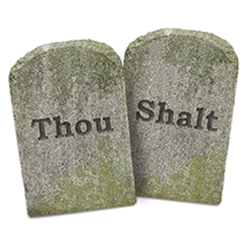 |
 Candy Adams,
Candy Adams,
CTSM, CME,
CEM, CMP, CMM,
is an independent exhibit-management
consultant, trainer, speaker, writer, and an Exhibitor conference
faculty member.
CandyAdams
@BoothMom.com
|
| |
 ccording to a 2009 study released by the Center for Exhibition Industry Research, 33.9 percent of companies' overall marketing budgets
go to trade shows. With such a sizeable investment in exhibits, your company executives undoubtedly want to see the return they're getting. But if you're not providing data to prove the effectiveness of your exhibit program, it's easy for them to view exhibit marketing as a money pit. ccording to a 2009 study released by the Center for Exhibition Industry Research, 33.9 percent of companies' overall marketing budgets
go to trade shows. With such a sizeable investment in exhibits, your company executives undoubtedly want to see the return they're getting. But if you're not providing data to prove the effectiveness of your exhibit program, it's easy for them to view exhibit marketing as a money pit.
However, if you take the time to look objectively at each show and consistently share your results with your management team, you'll be less vulnerable to budget cuts when comparisons are made between your exhibit program and other marketing programs. Plus, failure to demonstrate the value of your program and its impact on the company's bottom line will relegate you to the status of a gerbil on the logistics wheel, which doesn't equate to positive visibility or potential for promotion.
But what do executives want from your show reports? Typically, they're interested in four things about your exhibit-marketing efforts: strategy, results, budget, and plans for improvement. Along those lines, here are 10 sections to include in your report that will address each of these points and help prove your program's worth.
 Executive Summary Executive Summary
The first section of your post-show report should be able to stand alone as a summary of the whole show. This one-page executive brief may be the only part of your report many of your executives will read.
The executive summary should include five succinct sections: your strategic goals and objectives for the show; the most critical results such as your overall lead count, quality of leads, press interviews, number of branding impressions, number of prospects exposed to new product(s), etc.; a summary of the exhibit and accompanying activities; a budget summary; and any future goals and recommendations.
 Strategic Goals
and Objectives Strategic Goals
and Objectives
If you've done your homework before the show and written measurable, quantitative, and qualitative pre-show goals and objectives that have been approved by management, this section of your post-show report will be easy.
Start by providing the big picture - how your exhibit supports corporate goals and initiatives. Then, list each of your exhibit's pre-show objectives and evaluate whether you achieved them. Analyze any goals and objectives you did not meet and state how you will reach them at future shows, or revise them to make them more relevant. If you're doing a show-to-show or year-to-year comparison, keep the information you're comparing consistent.
 Sales-Lead Report Sales-Lead Report
Most companies' primary reason for exhibiting is to gather sales leads, so the quantity and quality of the leads gathered is of the utmost importance to your executives since, ideally, this will generate sales and revenue for your company.
First identify the total number of leads; then break that down into a qualitative assessment. Categorize the leads as A, B, and C leads, based on the type of prospect (individual buyer, dealer or distributor, or past customer), decision making power, need for and interest in your product, time frame to buy, budget, and desire for follow-up after the show. All of these criteria contribute to your company's ability to turn a lead into a sale. Clearly define your criteria for each lead category and list the number of leads gathered in each category.
Next, explain your lead follow-up process for each category of leads. What future follow-up is planned? How will you calculate and attribute sales to your participation at the trade show?
Finally, include hard numbers related to the bottom line. Calculate the cost per lead by dividing the direct costs of your trade show participation by the number of qualified leads. Talk with sales management to determine an estimated closing ratio of the leads, the potential average value of each sale, and a projected time period to close them. Then include that information in your show report to give a more global view of the value of those qualified leads.
 Press/Media Results Press/Media Results
Identify the number of press representatives and analysts who attended your press events or met with your press liaison or executive management. Then include the number of favorable press mentions you received within a specific time period after the show. If possible, include quotes or examples of the most prestigious coverage. Calculate the cost of equivalent advertising to reach a similarly sized audience.
If you don't already have an established method for quantifying the value of press mentions, begin by contacting each publication to find out what you'd have to pay for an ad of comparable size. (If the magazine published a half-page story on your new product, find out how much a half-page ad would cost.) According to the Public Relations Society of America, media coverage is more than twice as credible and conveys a higher influence on consumers than paid advertising. So multiply that cost by 2.5 to address the credibility factor of non-advertisement coverage. Then include that figure in your report as the total value of press coverage generated at the show.
 Exhibit Effectiveness Exhibit Effectiveness
Include a brief description and evaluation of your exhibit, including a photo or rendering and a statement on each of the following four components:
 Exhibit properties. Was the design of your exhibit functional to reach your goals and objectives? Was the condition of your exhibit properties consistent with the image your company wants to portray? Did you have any security issues, such as corporate espionage, competitive reconnaissance, or theft of any product or equipment during the show? Exhibit properties. Was the design of your exhibit functional to reach your goals and objectives? Was the condition of your exhibit properties consistent with the image your company wants to portray? Did you have any security issues, such as corporate espionage, competitive reconnaissance, or theft of any product or equipment during the show?
 Product displays. What products did you feature, and how were they displayed? Could visitors identify your separate products or product lines from a distance? How did visitors engage with the products? Product displays. What products did you feature, and how were they displayed? Could visitors identify your separate products or product lines from a distance? How did visitors engage with the products?
 Graphics. Did your graphics draw attendees into your booth from both far away and right in front of your exhibit? Were your messages clear and compelling? Graphics. Did your graphics draw attendees into your booth from both far away and right in front of your exhibit? Were your messages clear and compelling?
 Floor location, booth layout, and traffic flow. How did the location of the exhibit on the show floor affect traffic flow? Did the size and layout of your exhibit invite visitors to enter and remain in your exhibit long enough to engage with your staff? Floor location, booth layout, and traffic flow. How did the location of the exhibit on the show floor affect traffic flow? Did the size and layout of your exhibit invite visitors to enter and remain in your exhibit long enough to engage with your staff?
 Promotions and
Exhibit Activities Promotions and
Exhibit Activities
Review the effectiveness of each of your pre-show, at-show, and post-show promotional programs and sponsorships. This analysis can be both objective, such as measuring the number of attendees who returned a pre-show mailer to your exhibit in exchange for a gift, and subjective, such as feedback from press who attended an invitation-only press event in your exhibit to preview your new product.
Provide a brief synopsis of the type, length, and number of demonstrations and/or presentations held in the exhibit, including the total number of attendees who participated.
Report on any ancillary events, such as hospitality suites, customer thank-you dinners, hosted networking events, entertainment, co-sponsored events with partners, customer or dealer/distributor training, sponsored conference sessions, or participation by company employees or key clients in conference seminars.
 Booth Staff Booth Staff
Evaluate the effectiveness of your booth staff, so you can make improvements for the next show. Analyze the following details:
 Number of staff members. Did you have enough or too many staff members working during setup and teardown and during show hours? Number of staff members. Did you have enough or too many staff members working during setup and teardown and during show hours?
 Pre-show training. Review your exhibit staff's pre-show training in the following areas: strategy, product, boothmanship, and logistics. Was the training effective in enhancing your staff's understanding of show goals and in-booth behavior? Pre-show training. Review your exhibit staff's pre-show training in the following areas: strategy, product, boothmanship, and logistics. Was the training effective in enhancing your staff's understanding of show goals and in-booth behavior?
 Staff performance. Evaluate the productivity and effectiveness of your staff, mentioning your most effective members by name. Record problems with your staff, such as low productivity, tardiness or absences, or problems with customers. Staff performance. Evaluate the productivity and effectiveness of your staff, mentioning your most effective members by name. Record problems with your staff, such as low productivity, tardiness or absences, or problems with customers.
 Competitive Analysis Competitive Analysis
Include a brief summary about how your company stacked up against the competition. If you assigned exhibit staff to report on competitors' show activities, develop a comprehensive competitive analysis of competitors' products, exhibits, press kits, and events based on their feedback, and attach it to the report.
 Budget Budget
Everyone's pinching pennies these days, which means it's critically important to discuss your total show expenditures. Provide a comparison of your estimated budget to your final investment in the show. Point out everything you did to cut costs. If you still ended up going over budget, try to explain those charges and what caused them to come in higher than initially expected.
 Conclusion Conclusion
This section should put the show into context in your overall trade show program, considering both the past and the future. If applicable, provide a year-over-year comparison of results from the same show. Indicate how this year's show was stronger, or weaker, and why. Rank the show among the other shows in which you exhibit based on return on investment and overall impact to your corporate objectives.
Discuss what you want to continue doing and what you want to improve for future shows to advance your exhibit program. And even though it's much easier to highlight your successes at a show, don't be afraid to point out your program's shortcomings as well. In all likelihood, the management team will identify them anyway. But by proactively - and transparently - pointing them out, you demonstrate an awareness of problem areas and can take the opportunity to comment on your plans to address them in the future.e
|





 ccording to a 2009 study released by the Center for Exhibition Industry Research, 33.9 percent of companies' overall marketing budgets
go to trade shows. With such a sizeable investment in exhibits, your company executives undoubtedly want to see the return they're getting. But if you're not providing data to prove the effectiveness of your exhibit program, it's easy for them to view exhibit marketing as a money pit.
ccording to a 2009 study released by the Center for Exhibition Industry Research, 33.9 percent of companies' overall marketing budgets
go to trade shows. With such a sizeable investment in exhibits, your company executives undoubtedly want to see the return they're getting. But if you're not providing data to prove the effectiveness of your exhibit program, it's easy for them to view exhibit marketing as a money pit.


